Gregory J. Stein
Learning-Augmented Model-Based Multi-Robot Planning for Time-Critical Search and Inspection Under Uncertainty
Jul 08, 2025Abstract:In disaster response or surveillance operations, quickly identifying areas needing urgent attention is critical, but deploying response teams to every location is inefficient or often impossible. Effective performance in this domain requires coordinating a multi-robot inspection team to prioritize inspecting locations more likely to need immediate response, while also minimizing travel time. This is particularly challenging because robots must directly observe the locations to determine which ones require additional attention. This work introduces a multi-robot planning framework for coordinated time-critical multi-robot search under uncertainty. Our approach uses a graph neural network to estimate the likelihood of PoIs needing attention from noisy sensor data and then uses those predictions to guide a multi-robot model-based planner to determine the cost-effective plan. Simulated experiments demonstrate that our planner improves performance at least by 16.3\%, 26.7\%, and 26.2\% for 1, 3, and 5 robots, respectively, compared to non-learned and learned baselines. We also validate our approach on real-world platforms using quad-copters.
Anticipatory Planning for Performant Long-Lived Robot in Large-Scale Home-Like Environments
Nov 19, 2024Abstract:We consider the setting where a robot must complete a sequence of tasks in a persistent large-scale environment, given one at a time. Existing task planners often operate myopically, focusing solely on immediate goals without considering the impact of current actions on future tasks. Anticipatory planning, which reduces the joint objective of the immediate planning cost of the current task and the expected cost associated with future subsequent tasks, offers an approach for improving long-lived task planning. However, applying anticipatory planning in large-scale environments presents significant challenges due to the sheer number of assets involved, which strains the scalability of learning and planning. In this research, we introduce a model-based anticipatory task planning framework designed to scale to large-scale realistic environments. Our framework uses a GNN in particular via a representation inspired by a 3D Scene Graph to learn the essential properties of the environment crucial to estimating the state's expected cost and a sampling-based procedure for practical large-scale anticipatory planning. Our experimental results show that our planner reduces the cost of task sequence by 5.38% in home and 31.5% in restaurant settings. If given time to prepare in advance using our model reduces task sequence costs by 40.6% and 42.5%, respectively.
Anticipatory Task and Motion Planning
Jul 18, 2024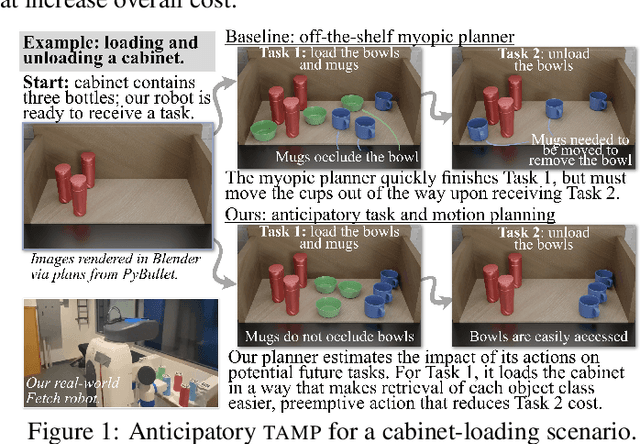



Abstract:We consider a sequential task and motion planning (tamp) setting in which a robot is assigned continuous-space rearrangement-style tasks one-at-a-time in an environment that persists between each. Lacking advance knowledge of future tasks, existing (myopic) planning strategies unwittingly introduce side effects that impede completion of subsequent tasks: e.g., by blocking future access or manipulation. We present anticipatory task and motion planning, in which estimates of expected future cost from a learned model inform selection of plans generated by a model-based tamp planner so as to avoid such side effects, choosing configurations of the environment that both complete the task and minimize overall cost. Simulated multi-task deployments in navigation-among-movable-obstacles and cabinet-loading domains yield improvements of 32.7% and 16.7% average per-task cost respectively. When given time in advance to prepare the environment, our learning-augmented planning approach yields improvements of 83.1% and 22.3%. Both showcase the value of our approach. Finally, we also demonstrate anticipatory tamp on a real-world Fetch mobile manipulator.
Active Information Gathering for Long-Horizon Navigation Under Uncertainty by Learning the Value of Information
Mar 05, 2024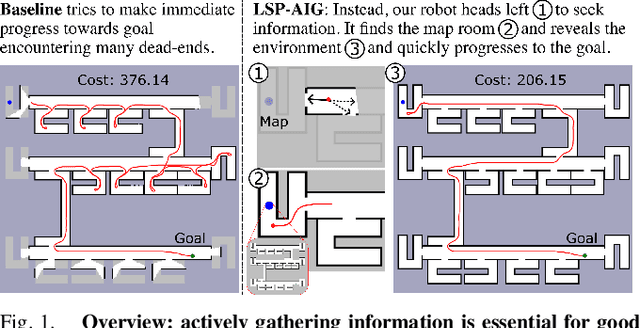

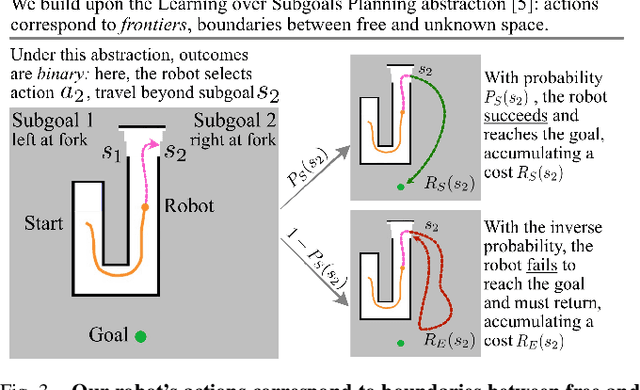
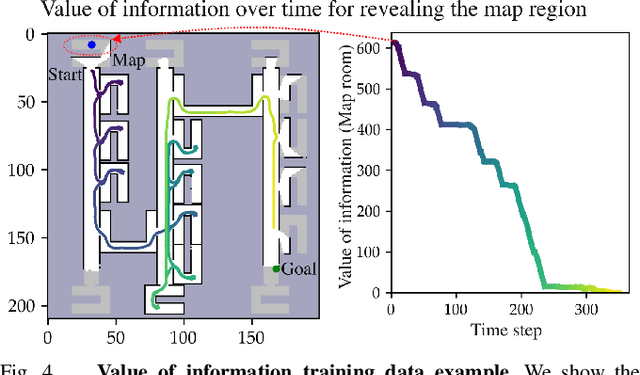
Abstract:We address the task of long-horizon navigation in partially mapped environments for which active gathering of information about faraway unseen space is essential for good behavior. We present a novel planning strategy that, at training time, affords tractable computation of the value of information associated with revealing potentially informative regions of unseen space, data used to train a graph neural network to predict the goodness of temporally-extended exploratory actions. Our learning-augmented model-based planning approach predicts the expected value of information of revealing unseen space and is capable of using these predictions to actively seek information and so improve long-horizon navigation. Across two simulated office-like environments, our planner outperforms competitive learned and non-learned baseline navigation strategies, achieving improvements of up to 63.76% and 36.68%, demonstrating its capacity to actively seek performance-critical information.
Improving Reliable Navigation under Uncertainty via Predictions Informed by Non-Local Information
Jul 26, 2023Abstract:We improve reliable, long-horizon, goal-directed navigation in partially-mapped environments by using non-locally available information to predict the goodness of temporally-extended actions that enter unseen space. Making predictions about where to navigate in general requires non-local information: any observations the robot has seen so far may provide information about the goodness of a particular direction of travel. Building on recent work in learning-augmented model-based planning under uncertainty, we present an approach that can both rely on non-local information to make predictions (via a graph neural network) and is reliable by design: it will always reach its goal, even when learning does not provide accurate predictions. We conduct experiments in three simulated environments in which non-local information is needed to perform well. In our large scale university building environment, generated from real-world floorplans to the scale, we demonstrate a 9.3\% reduction in cost-to-go compared to a non-learned baseline and a 14.9\% reduction compared to a learning-informed planner that can only use local information to inform its predictions.
Guided Sampling-Based Motion Planning with Dynamics in Unknown Environments
Jun 15, 2023Abstract:Despite recent progress improving the efficiency and quality of motion planning, planning collision-free and dynamically-feasible trajectories in partially-mapped environments remains challenging, since constantly replanning as unseen obstacles are revealed during navigation both incurs significant computational expense and can introduce problematic oscillatory behavior. To improve the quality of motion planning in partial maps, this paper develops a framework that augments sampling-based motion planning to leverage a high-level discrete layer and prior solutions to guide motion-tree expansion during replanning, affording both (i) faster planning and (ii) improved solution coherence. Our framework shows significant improvements in runtime and solution distance when compared with other sampling-based motion planners.
Anticipatory Planning: Improving Long-Lived Planning by Estimating Expected Cost of Future Tasks
May 08, 2023Abstract:We consider a service robot in a household environment given a sequence of high-level tasks one at a time. Most existing task planners, lacking knowledge of what they may be asked to do next, solve each task in isolation and so may unwittingly introduce side effects that make subsequent tasks more costly. In order to reduce the overall cost of completing all tasks, we consider that the robot must anticipate the impact its actions could have on future tasks. Thus, we propose anticipatory planning: an approach in which estimates of the expected future cost, from a graph neural network, augment model-based task planning. Our approach guides the robot towards behaviors that encourage preparation and organization, reducing overall costs in long-lived planning scenarios. We evaluate our method on blockworld environments and show that our approach reduces the overall planning costs by 5% as compared to planning without anticipatory planning. Additionally, if given an opportunity to prepare the environment in advance (a special case of anticipatory planning), our planner improves overall cost by 11%.
Data-Efficient Policy Selection for Navigation in Partial Maps via Subgoal-Based Abstraction
Apr 03, 2023

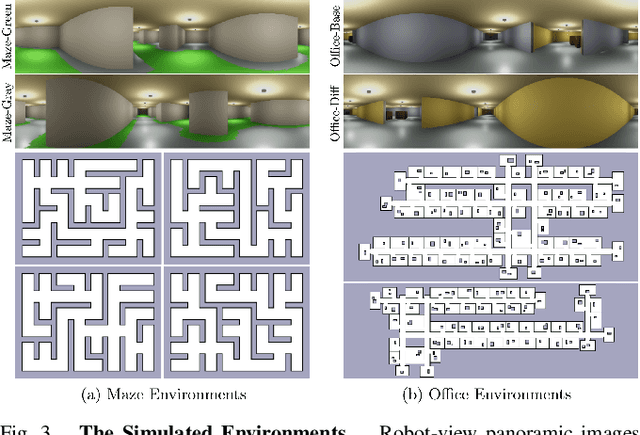

Abstract:We present a novel approach for fast and reliable policy selection for navigation in partial maps. Leveraging the recent learning-augmented model-based Learning over Subgoals Planning (LSP) abstraction to plan, our robot reuses data collected during navigation to evaluate how well other alternative policies could have performed via a procedure we call offline alt-policy replay. Costs from offline alt-policy replay constrain policy selection among the LSP-based policies during deployment, allowing for improvements in convergence speed, cumulative regret and average navigation cost. With only limited prior knowledge about the nature of unseen environments, we achieve at least 67% and as much as 96% improvements on cumulative regret over the baseline bandit approach in our experiments in simulated maze and office-like environments.
Learning Augmented, Multi-Robot Long-Horizon Navigation in Partially Mapped Environments
Mar 29, 2023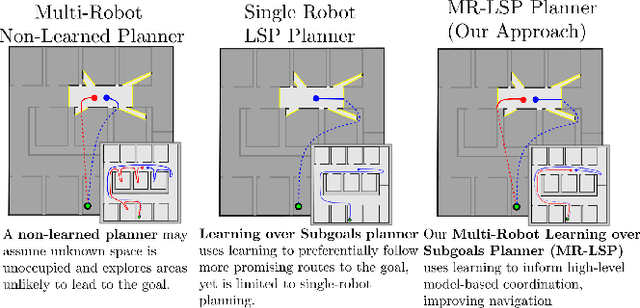

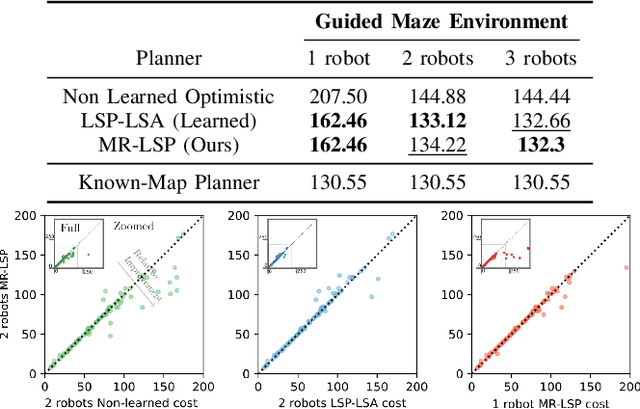
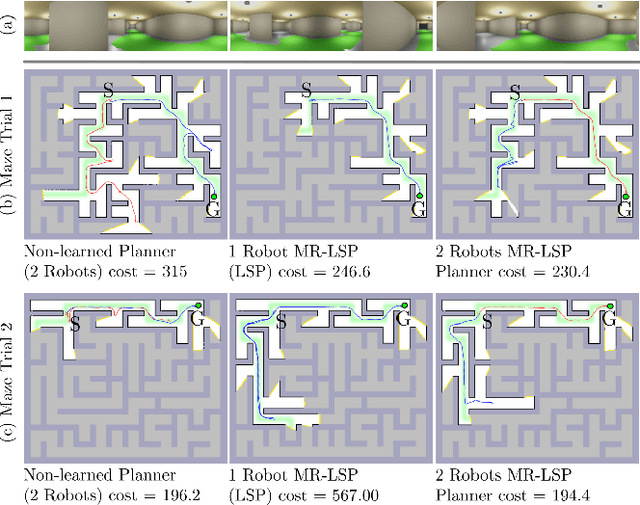
Abstract:We present a novel approach for efficient and reliable goal-directed long-horizon navigation for a multi-robot team in a structured, unknown environment by predicting statistics of unknown space. Building on recent work in learning-augmented model based planning under uncertainty, we introduce a high-level state and action abstraction that lets us approximate the challenging Dec-POMDP into a tractable stochastic MDP. Our Multi-Robot Learning over Subgoals Planner (MR-LSP) guides agents towards coordinated exploration of regions more likely to reach the unseen goal. We demonstrate improvement in cost against other multi-robot strategies; in simulated office-like environments, we show that our approach saves 13.29% (2 robot) and 4.6% (3 robot) average cost versus standard non-learned optimistic planning and a learning-informed baseline.
Comparison of Model-Free and Model-Based Learning-Informed Planning for PointGoal Navigation
Dec 17, 2022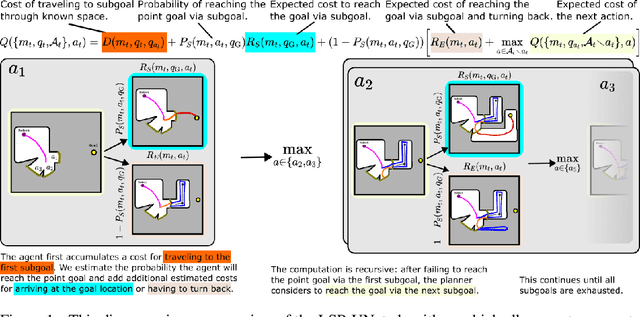
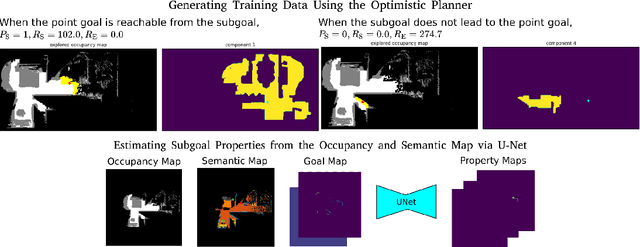
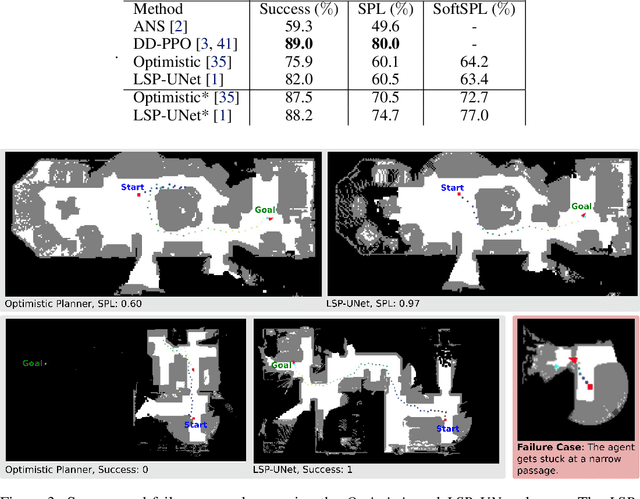
Abstract:In recent years several learning approaches to point goal navigation in previously unseen environments have been proposed. They vary in the representations of the environments, problem decomposition, and experimental evaluation. In this work, we compare the state-of-the-art Deep Reinforcement Learning based approaches with Partially Observable Markov Decision Process (POMDP) formulation of the point goal navigation problem. We adapt the (POMDP) sub-goal framework proposed by [1] and modify the component that estimates frontier properties by using partial semantic maps of indoor scenes built from images' semantic segmentation. In addition to the well-known completeness of the model-based approach, we demonstrate that it is robust and efficient in that it leverages informative, learned properties of the frontiers compared to an optimistic frontier-based planner. We also demonstrate its data efficiency compared to the end-to-end deep reinforcement learning approaches. We compare our results against an optimistic planner, ANS and DD-PPO on Matterport3D dataset using the Habitat Simulator. We show comparable, though slightly worse performance than the SOTA DD-PPO approach, yet with far fewer data.
 Add to Chrome
Add to Chrome Add to Firefox
Add to Firefox Add to Edge
Add to Edge